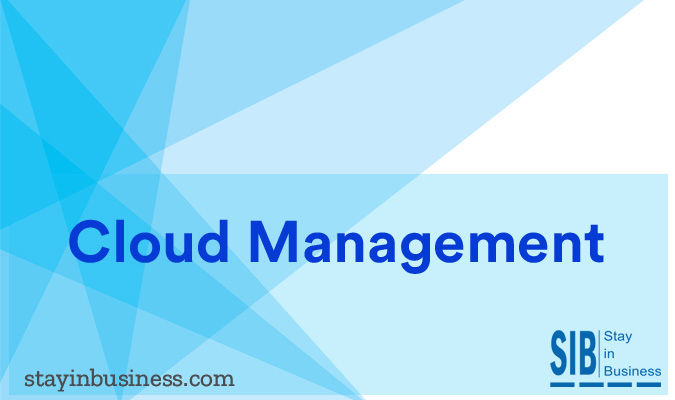
“Cloud”, now a day’s echoing everywhere, used widely for hosting the business applications safe and secured. The nuts and bolts of cloud management are well known to everyone now and not necessarily be explained. Cloud Management involves the process of keeping track of the performance of applications and data that dwell in the cloud and their security services by specially designed software and various technologies. In brief it is the management of cloud computing products and its services.
Cloud Management calls the shots on disaster recovery and contingency plans. It also does oversee the public, private and hybrid clouds. Cloud management equips users with overall control on the cloud environment. To make sure that an enterprises cloud based computing resources are doing their job in a proper way interacting with the users and enhancing other services, they need to use the cloud management tools.
The businesses with huge budget would require much vigorous cloud management tools with special dexterity to manage various platforms from a single individual point of reference and need brilliant systematic analysis in processing applications automatically. The concept of cloud management platform came up to handle the system failures automatically with capabilities such as self-monitoring, a lucid proclamation system, and include fail-over and self-healing capabilities. Both the physical and virtual resources of a cloud platform can be managed by the cloud management system software that was designed for special reasons.
The Cloud Management system should posses certain capabilities to survive its purpose.
- Self-service provision
- Ride herd on tracking
- Enable work flow automation
- Access provision to the end users
- Monitor Security
- Cost depreciation
- Provides Reliability
- Resource allocation managed
- Back-up provision ahead of time
- Manage a pool of various compute-resources
- Girdle frameworks for workflow management
Big league Benefits of Cloud Management:
Brisk Consignment – After failing with many traditional storage and service systems the enterprises got hooked on to Cloud which is reliable for stashing their data and applications safeguarded. The agile nature of cloud makes it easier for customers to avail the best out of it and the Cloud Management assists in so.
Enormous Flexibility – The self-service provisioning system is like a shot in the arm for customers that allows complete control over the cloud. They can choose the services they need and pay for those used. Obviously the costs are cut down to a significant level.
Mound up Money with agile solution – Cloud Management benefits the businesses in all the aspects much better when compared to the conventional methods additionally saving bucks.
Visibility Provision – Customers can learn about how much bandwidth is used and where exactly it is used by the visibility factor provided by the Cloud Management system. Customers can get cost control over things with more transparency.
Blue-penciled costs – The costs are tamed automatically with less usage of hardware in cloud and so that businesses avail the advantage without any cold feet.
Scalability – The process of automation helps enterprises to calculate the usage of resources, performance of the applications and allow them to resolve the issues if any present.
As the saying Good and Bad travel together, similarly along with the benefits of Cloud there are certain challenges accompanied and have to be faced by it. With surplus users the consistency and reliability factors have been a challenge. When self-service provision is given it accompanies inefficiency and frittered away resources which are controlled by Cloud Management software system. A profound security is maintained throughout the process. Cloud management get the customers dodge away from those cloud challenges without a hitch using its management tools and enable them to get a kick out of complete Cloud Management.
The cloud management has to integrate the tool set to make it work but this is a task accomplished by the cloud platform providing improved quality of service and helps businesses stay focused on key functionalities. Companies also need the cloud management capabilities necessary to fail-over their operations to multiple infrastructures in a way that keeps things up and running. Even though the cloud is not run by IT the tools that assist in running the cloud are run by them. So, to achieve a successful cloud management, IT team is also vital. With proper architecture and management layer, the cloud based services can provide un-parallel disaster protection and business continuity. In other words with Cloud Management the customers can let it all hang out.
Disasters
[carousel id=’1780′ items=’4′ items_desktop=’3′ margin_right=’5′ navigation=’false’] [item img_link=”https://www.stayinbusiness.com/wp-content/uploads/2016/02/Chemical-Spills-Discharges.jpg” href=”https://www.stayinbusiness.com/resource/disaster-recovery/chemical-spills-and-discharges/”][item img_link=”https://www.stayinbusiness.com/wp-content/uploads/2016/02/Riots-Public-Disturbances.jpg” href=”https://www.stayinbusiness.com/resource/disaster-recovery/riots-and-public-disturbances/”][item img_link=”https://www.stayinbusiness.com/wp-content/uploads/2016/02/Terrorism.jpg” href=”https://www.stayinbusiness.com/resource/disaster-recovery/terrorism/”] [item img_link=”https://www.stayinbusiness.com/wp-content/uploads/2016/02/worst-product-recall.jpg” href=”https://www.stayinbusiness.com/resource/disaster-recovery/product-recall/”] [/carousel]




